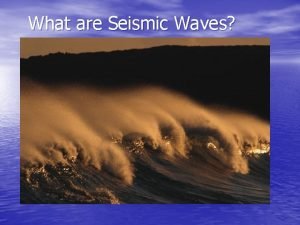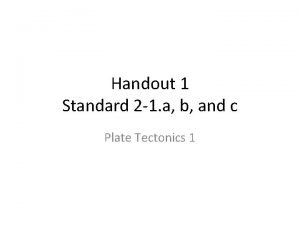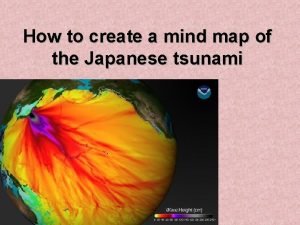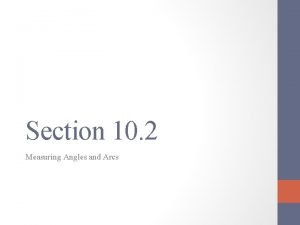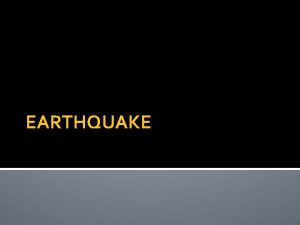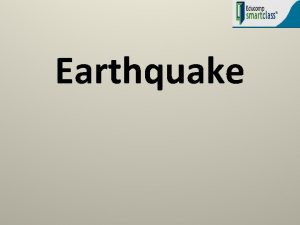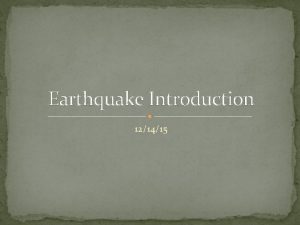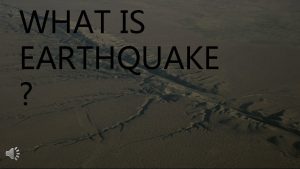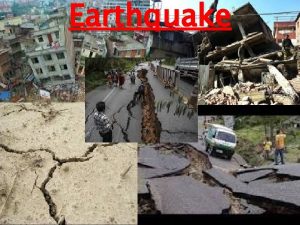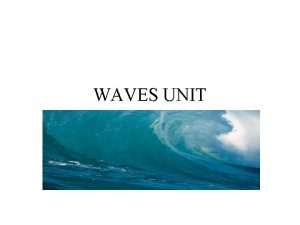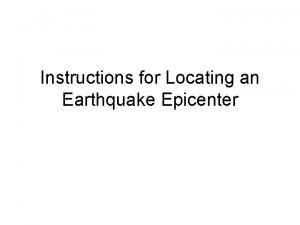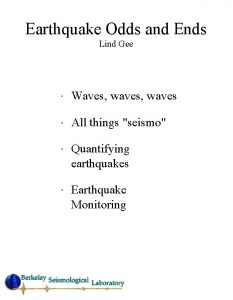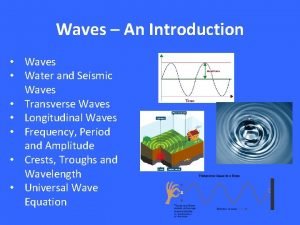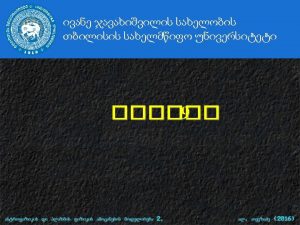Unit 4 Lesson 6 Measuring Earthquake Waves Copyright




















- Slides: 20

Unit 4 Lesson 6 Measuring Earthquake Waves Copyright © Houghton Mifflin Harcourt Publishing Company

Unit 4 Lesson 6 Measuring Earthquake Waves Shake, Rattle, and Roll What happens during an earthquake? • As plates of the lithosphere move, the stress on rocks at or near the edges of the plates increases. This stress causes faults to form. • A fault is a break in a body of rock along which one block moves relative to another. • When rocks along a fault break and move, energy is released into the surrounding rock in the form of waves, causing earthquakes. Copyright © Houghton Mifflin Harcourt Publishing Company

Unit 4 Lesson 6 Measuring Earthquake Waves What happens during an earthquake? • The location along a fault at which the first motion of an earthquake takes place is called the focus. • The epicenter is the point on Earth’s surface directly above an earthquake’s starting point or focus. Copyright © Houghton Mifflin Harcourt Publishing Company

Unit 4 Lesson 6 Measuring Earthquake Waves What happens during an earthquake? • When rocks along a fault slip, the energy released travels away from the focus and through Earth in all directions as seismic waves. • Seismic waves are vibrations that cause different types of ground motion. • The strength of an earthquake is based on the energy that is released as rocks break and return to an undeformed shape. Copyright © Houghton Mifflin Harcourt Publishing Company

Unit 4 Lesson 6 Measuring Earthquake Waves of Motion What are two kinds of seismic waves? • There are two kinds of seismic waves: body waves and surface waves. Each kind travels through Earth in different ways and at different speeds. • Seismic waves carry energy, and their speed depends on the material through which they travel. • Body waves are seismic waves that travel through Earth’s interior. They are further divided into P waves and S waves. Copyright © Houghton Mifflin Harcourt Publishing Company

Unit 4 Lesson 6 Measuring Earthquake Waves What are two kinds of seismic waves? • P waves, also called pressure waves or primary waves, are the fastest body waves. • P waves can travel through solids, liquids, and gases. They cause rock to move back and forth in the direction the wave is traveling. • S waves, also called shear waves or secondary waves, move rock from side to side. They cannot travel through completely liquid parts of Earth. Copyright © Houghton Mifflin Harcourt Publishing Company

Unit 4 Lesson 6 Measuring Earthquake Waves What are two kinds of seismic waves? • Seismic waves that travel along Earth’s surface are called surface waves. • Body waves travel more rapidly than surface waves do, but the latter, being focused on Earth’s surface, cause more damage. • Surface waves produce two types of ground motion: up-and-down and back-and-forth. Copyright © Houghton Mifflin Harcourt Publishing Company

Unit 4 Lesson 6 Measuring Earthquake Waves What are two kinds of seismic waves? • Identify the different types of seismic waves. Copyright © Houghton Mifflin Harcourt Publishing Company

Unit 4 Lesson 6 Measuring Earthquake Waves Wave Action! How are seismic waves measured? • Scientists use instruments called seismometers to record seismic waves. When seismic waves reach a seismometer, it produces a seismogram. • A seismogram is a tracing of earthquake motion. It also records the arrival times of seismic waves at a seismometer station. • Seismograms are plotted on a graph, which is then used to pinpoint the earthquake’s epicenter. Copyright © Houghton Mifflin Harcourt Publishing Company

Unit 4 Lesson 6 Measuring Earthquake Waves How is an earthquake’s epicenter located? • In the S-P time method, scientists use the lag time between P and S waves to determine how far the waves have traveled from the epicenter. • In a process called triangulation, the epicenter can be located by drawing circles around at least three seismometer stations on a map. • The radius of each circle equals the distance from that station to the earthquake’s epicenter. The point of intersection of the circles is the epicenter. Copyright © Houghton Mifflin Harcourt Publishing Company

Unit 4 Lesson 6 Measuring Earthquake Waves How is earthquake magnitude measured? • The height of the waves on a seismogram indicates the amount of ground motion. • Ground motion can be used to calculate magnitude, the measure of energy released by an earthquake. • The larger the magnitude, the stronger the earthquake. Copyright © Houghton Mifflin Harcourt Publishing Company

Unit 4 Lesson 6 Measuring Earthquake Waves How is earthquake magnitude measured? • The Richter scale measures the ground motion from an earthquake to find the earthquake’s strength. • An increase in the magnitude by one unit corresponds to a ten-fold increase in ground motion. Copyright © Houghton Mifflin Harcourt Publishing Company

Unit 4 Lesson 6 Measuring Earthquake Waves How is earthquake magnitude measured? • Earthquake strength is also measured by the Moment Magnitude scale, which is more accurate for large earthquakes than the Richter scale is. • It is based on the size of the area of the moving fault, the average distance that the fault moves, and the rigidity of the rocks in the fault. • The moment magnitude of an earthquake is expressed by a number. The larger the number, the stronger the earthquake. Copyright © Houghton Mifflin Harcourt Publishing Company

Unit 4 Lesson 6 Measuring Earthquake Waves How is earthquake intensity measured? • The effects of an earthquake and how the earthquake is felt by people are known as the earthquake’s intensity. • Magnitude measures how much energy is released by an earthquake. Intensity measures the effects of an earthquake at Earth’s surface. • The Modified Mercalli scale is used to describe an earthquake’s intensity. Intensity values are usually highest near the epicenter. Copyright © Houghton Mifflin Harcourt Publishing Company

Unit 4 Lesson 6 Measuring Earthquake Waves Damage Control What factors determine the effects of an earthquake? • Four factors determine the effects of an earthquake: magnitude, local geology, distance from the epicenter, and type of construction used. • An earthquake’s magnitude is directly related to its strength. Stronger earthquakes cause more damage than weaker earthquakes. • As an earthquake’s magnitude increases, the earthquake’s intensity is commonly higher. Copyright © Houghton Mifflin Harcourt Publishing Company

Unit 4 Lesson 6 Measuring Earthquake Waves What factors determine the effects of an earthquake? • When water-saturated soil or sediment is shaken by seismic waves, the soil and sediment particles become completely surrounded by water. • This process is called liquefaction. • It can intensify ground shaking or cause the ground to settle. Settling can cause structures to tilt or collapse. Copyright © Houghton Mifflin Harcourt Publishing Company

Unit 4 Lesson 6 Measuring Earthquake Waves What factors determine the effects of an earthquake? • Which diagram shows soil particles before an earthquake causes liquefaction? Which diagram shows the same particles after liquefaction has occurred? Copyright © Houghton Mifflin Harcourt Publishing Company

Unit 4 Lesson 6 Measuring Earthquake Waves What factors determine the effects of an earthquake? • The more energy a surface wave carries, the stronger the ground motion will be and the more damage the wave will cause. • However, surface waves decrease in size and energy the farther they travel from the epicenter. • Therefore, the farther an area is located from the epicenter, the less damage it will suffer. Copyright © Houghton Mifflin Harcourt Publishing Company

Unit 4 Lesson 6 Measuring Earthquake Waves What factors determine the effects of an earthquake? • The materials with which structures are built also determine the amount of earthquake damage. • Flexible structures are more likely to survive strong ground shaking. • Taller buildings are more susceptible to damage than shorter buildings. Copyright © Houghton Mifflin Harcourt Publishing Company

Unit 4 Lesson 6 Measuring Earthquake Waves What factors determine the effects of an earthquake? • Special technologies control how much tall buildings sway during earthquakes. Copyright © Houghton Mifflin Harcourt Publishing Company
 Seismic wave types
Seismic wave types Seismic waves types
Seismic waves types Differences between mechanical and electromagnetic waves
Differences between mechanical and electromagnetic waves Light waves are electromagnetic waves true or false
Light waves are electromagnetic waves true or false Mechanical waves and electromagnetic waves similarities
Mechanical waves and electromagnetic waves similarities Mechanical waves and electromagnetic waves similarities
Mechanical waves and electromagnetic waves similarities What type of waves are sound waves? *
What type of waves are sound waves? * Sound is a longitudinal wave
Sound is a longitudinal wave Long waves and short waves
Long waves and short waves Difference between matter waves and electromagnetic waves
Difference between matter waves and electromagnetic waves Mechanical vs electromagnetic
Mechanical vs electromagnetic Mechanical and electromagnetic waves similarities
Mechanical and electromagnetic waves similarities Seismic waves
Seismic waves Is a seismic wave mechanical or electromagnetic
Is a seismic wave mechanical or electromagnetic Compare and contrast p waves and s waves using venn diagram
Compare and contrast p waves and s waves using venn diagram Mechanical wave and electromagnetic wave
Mechanical wave and electromagnetic wave Aimtoknow
Aimtoknow Map of tsunami
Map of tsunami Hyp opp adj triangle
Hyp opp adj triangle Measuring angles and arcs 10-2 answers
Measuring angles and arcs 10-2 answers The mole lesson 9.1 measuring matter
The mole lesson 9.1 measuring matter
